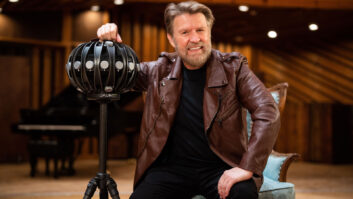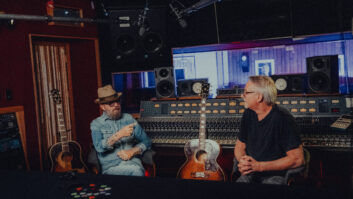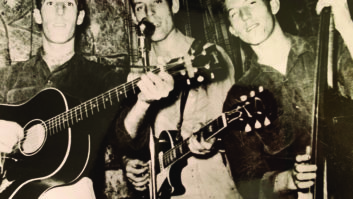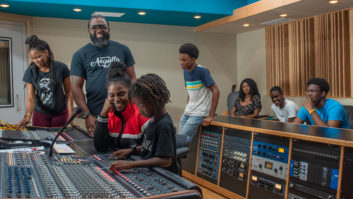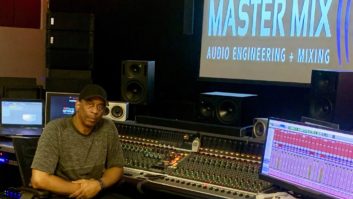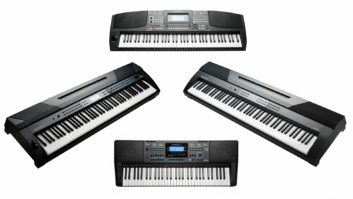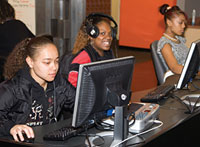
At Youth Radio, students learn to use Pro Tools, Audition and other creative apps.
This year, something truly transformative is happening in the lives of more than a thousand teenagers and young adults who live in the San Francisco Bay Area. Coming from mostly low-income households and ailing education systems, these young people are learning first-hand about the new world of converged media, thanks to a non-profit organization that offers free, hands-on classes and career training to high school students. You may have heard their segments on NPR stations, iTunes or a growing list of other outlets. It’s all happening at Youth Radio (www.youthradio.org) in Oakland, Calif.
As the organization’s Website states, “Youth Radio’s mission is to promote young people’s intellectual, creative and professional growth through training and access to media, and to produce the highest-quality original media for local and national outlets.” Youth Radio was founded in 1992 and maintains its free program offerings through voluntary financial donations and sponsorships from corporations and foundations. Students can apply by downloading an application from Youth Radio’s Website.
These young people create programming based on their own point of view, with news and commentary about topics ranging from music to global politics. “These students are tastemakers, as well as cultural documentarians, looking at how a story affects young people and extracting the youth perspectives,” says news director Nishat Kurwa. “For an adult audience like NPR, they’re often looking for young people to translate what’s happening among other teenagers, translate cultures, what they’re listening to and why, and the kind of decisions they make about their lives. It’s a powerful look into the lives of teenagers — from them, not from an adult parachuting into teenagers’ lives and telling their story for them, which is usually the only way young people show up in the mainstream.”
Youth Radio’s training opportunities include two 10-week programs called Core and Bridge. The Core program offers an overview of journalism and broadcasting, including the fundamentals of radio and television broadcast, music programming, Web design, and music and video production. Students can work with Reason, Audacity and other creative software. The Bridge program provides intermediate-level training, allowing students to focus on areas of specific interest. Students can learn to use Pro Tools, Audition, video editing and Web design applications, and other creative apps. Youth Radio is working with the Peralta Colleges to bring its curriculum in line with California Community College standards so that students can earn college credit for their work.
Students who successfully complete these programs can apply for Youth Radio’s internship program. Interns continue working on personal projects and work as peer teachers, for which they receive modest pay. Many staff members are former students, either directly from the Youth Radio program or alumni who have worked in media-related industries, or gone on to college or university programs and returned to what feels like an extended family.
Youth Radio has always emphasized quality production standards, and the team has earned many accolades for their programming, including a Peabody Award and two Edward R. Murrow Awards from the Radio Television News Directors Association and the United Nations Department of Public Information Gold and Bronze Medals awarded for “work that best exemplifies the ideals and goals of the United Nations.”
The Facility
After 17 years, Youth Radio outgrew its original facility and analog equipment and recently acquired a new home: a remodeled three-story bank building near Oakland’s City Center, on the corner of Broadway and 17th Street. The new building will include industry-standard equipment and has an unexpected “wow” factor. “The professional look and feel of the facility creates an atmosphere of quality to inspire students and peer teachers,” says Tim McGovern, Youth Radio’s technical director. “‘All this for kids?’ is a question some visitors ask.”
With decades of experience at Skywalker Sound, American Zoetrope, Sony Systems Integration Division and David Carroll Associates, McGovern knows facilities. He left his technical director position at Skywalker two years ago to devote his full attention to building out Youth Radio’s new premises.
The new facility includes two on-air control rooms, a production control room with a voice studio, music production rooms, two news production rooms, edit booths and a performance space. There is also a computer lab, DJ workstations and more. Meyer Sound was kind enough to give a huge break to Youth Radio so that the building could have 5.1 sound in the production control room and performance space.
Youth Radio’s training programs require a wide range of radio, music, video and IP facilities. “The technical challenge in this facility was making it handle converged media, which is still not perfectly defined,” says McGovern. “Building a music studio, a film studio or a radio studio isn’t that difficult, but building a studio that can do all those things is a bit of a juggling act. Behind all the thinking and decisions of what equipment would go into the building was having that kind of flexibility.”
The organization purchased and installed a building-wide system of audio engines and routers from Logitek Electronic Systems (www.logi tekaudio.com), along with Logitek’s Mosaic and Artisan digital console control surfaces, which live in specific rooms. Youth Radio chose this system because of its flexibility in assigning different controllers to audio resources. Logitek’s multithousand-dollar production consoles, broadcast consoles or virtual mixers can provide system control using a free Logitek application on any computer in the facility.
Having all your faders in one basket could be cause for concern to the person tasked with keeping it all working, but McGovern says, “There are workarounds for all of this, many that I just discovered — like always having everything on a local engine so if the Logitek network fails, you can at least get at it with tie-lines and patch it around. The IT, although fully integrated as part of the system, is a separate discipline. All of our audio is very reliant on that IT system. That’s where our data lives, that’s how I get one machine to talk to another. Again, we’re back to converged technologies.”
All students have a unique sign-on associated with their profile, the applications they are using and project data so they can work at any computer in the facility. For instance, there are 15 computers in the first-floor lab, so if the class spills over to 20 the students can usually use other machines located nearby. In total, there are more than 100 CPUs running on a daily basis.
Currently, there are three main servers, each with 2TB RAID Level-5 arrays with online spares, redundant power supplies, uninterruptible power supplies and dual 2GB fiber-network interface controllers. Incremental backups are performed daily, with a full backup every weekend to DLT3 with an auto-loader. “No failures yet,” notes IT network administrator Josh Broughton. “Everything can be restored up to two weeks prior to an incident.”
While Broughton keeps all the proper firewalls and security on the network, he and his team are also involved in the spirit and mission of Youth Radio. “The adults that work here are just setting the stage. Young people come in and hopefully make it their own and bring it to the next place. We listen to them: What’s next? What do we need to plug in? What do you want to see happen?”
Broadcast connection to various outlets is mainly done via ISDN through a Telos Zephyr unit, and Webcasts are carried through a T1 line with guaranteed bandwidth. Currently, streams are served out by Net2EZ managed data centers, a very generous partner in Los Angeles.
Future Growth
This strong IT foundation is needed to allow for Youth Radio’s future plans: Web 2.0, featuring more user-generated content and social networking, with in-house servers and a greatly expanded video-production capacity. To accommodate the needs of Web 2.0 and in-house serving, Youth Radio is working out a deal with AT&T for a DS3 class of service. The goal is for content management of all video and audio in one on-site repository. Youth Radio’s Web traffic is currently at 600,000 unique visitors a month, and the anticipated Web 2.0 expansion will require more bandwidth.
Youth Radio is also spinning off a production company called Youth Media International (YMI), which will include Web production sponsored by ZeroDivide, a technology foundation that invests in non-profit organizations helping low-income and underserved communities, and more. Youth Media International’s first pilot concept series is titled What’s the New What.
Additionally, the Kellogg Foundation is developing a new long-term initiative that includes Youth Radio. “Youth Radio was selected as one of six community-based organizations across the nation to help develop a national model for getting youth who are out of school and work into jobs,” says managing director Jacinda Abcarian. “It’s pretty revolutionary because it’s not working with the established school systems — it’s a whole new model on how to get business- and community-based organizations to work together to create jobs and hire these young people.”
Steve Shurtz is the former general manager of the Saul Zaentz Film Center (Berkeley, Calif.) and former general manager of EMI’s Studios 301 in Sydney, Australia.

